Jesse Bythell
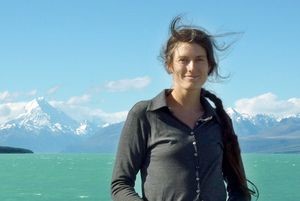 Jesse Bythell at Lake PukakiI originally trained as a linguist but found myself transferring my interest from endangered languages to endangered plants when I moved from Christchurch to the deep south in 2006. I lead the NZPCN web team and have been involved with NZPCN since 2010. I have interests in science communication, alpine flora, plant photography, botanical etymology, gardening, hunting, tramping and horse riding. Some of my earliest plant memories are of habitually climbing (and falling out of) a large plum tree, the smell of the beech forest mingled with salt and sunscreen on Marlborough Sounds family holidays and learning the names of all the ‘pitty farlies’ in my Nana’s garden. I think my favourite tree will always be southern rātā but I also have a strong fondness for all our weird and wonderful small-leaved tree daisies.
Jesse Bythell at Lake PukakiI originally trained as a linguist but found myself transferring my interest from endangered languages to endangered plants when I moved from Christchurch to the deep south in 2006. I lead the NZPCN web team and have been involved with NZPCN since 2010. I have interests in science communication, alpine flora, plant photography, botanical etymology, gardening, hunting, tramping and horse riding. Some of my earliest plant memories are of habitually climbing (and falling out of) a large plum tree, the smell of the beech forest mingled with salt and sunscreen on Marlborough Sounds family holidays and learning the names of all the ‘pitty farlies’ in my Nana’s garden. I think my favourite tree will always be southern rātā but I also have a strong fondness for all our weird and wonderful small-leaved tree daisies.
Alex Fergus
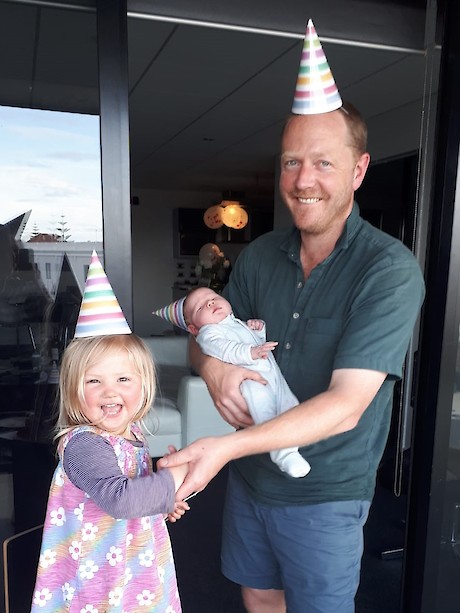 Alex and his two daughters, Rātā and IdaThe smell of mashing geraniums into the top of a concrete water tank as a tot endures in my head as the smell of plant-love and freedom (North Canterbury). Geraniums to thyme (Clyde); thyme to willows (Lauder); it took tertiary education in Dunedin to get me out of weed-love and into some natural NZ ecosystems. Apart from some international sojourns (Zurich, Rennes, Russian Far East) I’ve tried not to look back. I poorly balance young family time (Rātā and Ida) with garden time with field time and currently minimal extracurricular flora-focused adventures. I work for Manaaki Whenua – Landcare Research as a field botanist, a great role that lets me interact with plants all over Aotearoa. I have much love for Horomaka – Banks Peninsula, which I live on the edge of, but have a constant low-level craving for silver beech forest, anywhere alpine, and the Subantarctic. Until recently, I always identified pōkākā as my favourite tree, but tāwari may have overtaken it; then again I recently met Streblus smithii – blew my mind.
Alex and his two daughters, Rātā and IdaThe smell of mashing geraniums into the top of a concrete water tank as a tot endures in my head as the smell of plant-love and freedom (North Canterbury). Geraniums to thyme (Clyde); thyme to willows (Lauder); it took tertiary education in Dunedin to get me out of weed-love and into some natural NZ ecosystems. Apart from some international sojourns (Zurich, Rennes, Russian Far East) I’ve tried not to look back. I poorly balance young family time (Rātā and Ida) with garden time with field time and currently minimal extracurricular flora-focused adventures. I work for Manaaki Whenua – Landcare Research as a field botanist, a great role that lets me interact with plants all over Aotearoa. I have much love for Horomaka – Banks Peninsula, which I live on the edge of, but have a constant low-level craving for silver beech forest, anywhere alpine, and the Subantarctic. Until recently, I always identified pōkākā as my favourite tree, but tāwari may have overtaken it; then again I recently met Streblus smithii – blew my mind.
Bill Campbell
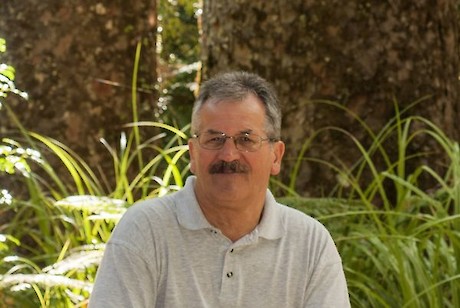 Bill Campbell, Puketi Forest, NorthlandFrom my childhood I’ve had a keen interest in the natural environment, particularly native birds, plants and animals. Unfortunately, these interests had to be put on the backburner for a long time while I was a family man pursuing a career. Since 2007, when a friend reintroduced me to botany, I’ve got back into exploring with a vengeance. Native orchids are of special interest to me and I take every opportunity I can to track species down and photograph them in their natural habitat. I am also very interested in rare and threatened plant species, particularly those found in the Northland region, where I live. If I am free, I enjoy guiding visiting enthusiasts to local hot spots to share with them some of the natural beauty that Aotearoa’s far north has to offer.
Bill Campbell, Puketi Forest, NorthlandFrom my childhood I’ve had a keen interest in the natural environment, particularly native birds, plants and animals. Unfortunately, these interests had to be put on the backburner for a long time while I was a family man pursuing a career. Since 2007, when a friend reintroduced me to botany, I’ve got back into exploring with a vengeance. Native orchids are of special interest to me and I take every opportunity I can to track species down and photograph them in their natural habitat. I am also very interested in rare and threatened plant species, particularly those found in the Northland region, where I live. If I am free, I enjoy guiding visiting enthusiasts to local hot spots to share with them some of the natural beauty that Aotearoa’s far north has to offer.
Matt Ward
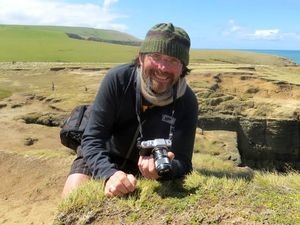 At Slope Point Southernmost point of the Mainland looking at Selliera radicans.After ditching the world of baking for conservation I’ve been very fulfilled. I went on a roady the length of Aotearoa in 2004 which ended with a conservation conversation at Waitiki Landing, this involved many questions for the local DOC ranger about how to join the force. This led to a couple of Victoria University degrees and some volunteer work at Karori Wildlife Sanctuary whilst studying. I have now been working with our native plants since 2006 and have become a chronic sufferer of orchid fever. I run my own ecological restoration business which allows me some time to botanise, and collect and process native seeds. I also attempt to be a botanical photographer and artist. Any spare time is enjoyed dining at home with my wife and friends, gardening, continually modifying something around the house, as well as making tasty home brew beverages.
At Slope Point Southernmost point of the Mainland looking at Selliera radicans.After ditching the world of baking for conservation I’ve been very fulfilled. I went on a roady the length of Aotearoa in 2004 which ended with a conservation conversation at Waitiki Landing, this involved many questions for the local DOC ranger about how to join the force. This led to a couple of Victoria University degrees and some volunteer work at Karori Wildlife Sanctuary whilst studying. I have now been working with our native plants since 2006 and have become a chronic sufferer of orchid fever. I run my own ecological restoration business which allows me some time to botanise, and collect and process native seeds. I also attempt to be a botanical photographer and artist. Any spare time is enjoyed dining at home with my wife and friends, gardening, continually modifying something around the house, as well as making tasty home brew beverages.
Sarah Beadel
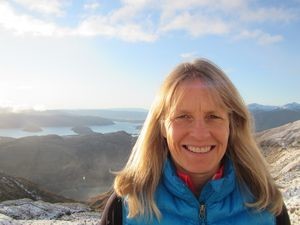 Sarah is a Founding Director of Wildland Consultants Ltd, and is a very keen botanist and ecologist who is passionate about working and exploring in the field throughout New Zealand, and overseas whenever she gets the opportunity. Sarah has prepared many ecological restoration plans and has often led or been involved with their implementation. When not botanising, Sarah is establishing a large native garden along with a large, productive vegetable garden that feeds family and friends. Mountain biking provides excellent botanical exploration opportunities in out-of-the way places. Sarah has served on the NZPCN committee since 2004. She is passionate about indigenous plants and ecological restoration, and is the author of more than 500 botanical reports, papers, and articles, including author or co- author of 17 protected natural area programme survey reports.
Sarah is a Founding Director of Wildland Consultants Ltd, and is a very keen botanist and ecologist who is passionate about working and exploring in the field throughout New Zealand, and overseas whenever she gets the opportunity. Sarah has prepared many ecological restoration plans and has often led or been involved with their implementation. When not botanising, Sarah is establishing a large native garden along with a large, productive vegetable garden that feeds family and friends. Mountain biking provides excellent botanical exploration opportunities in out-of-the way places. Sarah has served on the NZPCN committee since 2004. She is passionate about indigenous plants and ecological restoration, and is the author of more than 500 botanical reports, papers, and articles, including author or co- author of 17 protected natural area programme survey reports.
Melissa Hutchison
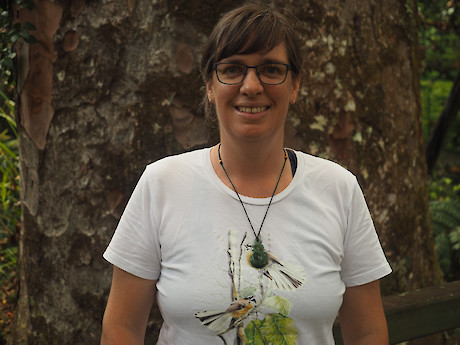 Melissa Hutchison, visiting giant kauri in NorthlandI developed a love of native plants and wild places growing up in the rugged Waitakere Ranges of West Auckland. In 2003, I moved to Ōtautahi/Christchurch to start a PhD at the University of Canterbury, and worked part-time as an ecologist for NZ Landcare Trust. This opened my eyes to the highly threatened ecosystems of lowland Canterbury and the challenge to protect the small fragments that remain. I currently work as an ecological consultant in Christchurch. I love tramping and exploring the South Island, especially naturally uncommon habitats with rare/obscure plant or lichen species, and am a keen observer and curator for iNaturalist (https://inaturalist.nz/people/56952). I also enjoy learning languages, particularly Te Reo Māori. I’ve been an NZPCN Council member since 2013 and am the website manager for Canterbury Botanical Society.
Melissa Hutchison, visiting giant kauri in NorthlandI developed a love of native plants and wild places growing up in the rugged Waitakere Ranges of West Auckland. In 2003, I moved to Ōtautahi/Christchurch to start a PhD at the University of Canterbury, and worked part-time as an ecologist for NZ Landcare Trust. This opened my eyes to the highly threatened ecosystems of lowland Canterbury and the challenge to protect the small fragments that remain. I currently work as an ecological consultant in Christchurch. I love tramping and exploring the South Island, especially naturally uncommon habitats with rare/obscure plant or lichen species, and am a keen observer and curator for iNaturalist (https://inaturalist.nz/people/56952). I also enjoy learning languages, particularly Te Reo Māori. I’ve been an NZPCN Council member since 2013 and am the website manager for Canterbury Botanical Society.
Taylor Davies-Colley
 Taylor geeking out over Tupeia antartica at a teachers professional development workshopI grew up among the beaches and kauri forests of Northland. This surrounding, and the influence of my parents’ passions for gardening and forestry, led me to a natural fascination with flora. I followed this interest to the University of Otago, to study a BSc in Botany and Ecology, and then a Masters researching the decline of one of our threatened carnivorous plant species; Utricularia australis. While at university, I released that, while I really liked researching plants, I loved talking about them more. Over the years I have been increasingly involved with community nature projects and environmental education. I currently work doing conservation education and community outreach. When I am not spreading the word about protecting native species, I try to get out into the amazing environment that surrounds Ōtepoti/Dunedin or wherever else I can get to.
Taylor geeking out over Tupeia antartica at a teachers professional development workshopI grew up among the beaches and kauri forests of Northland. This surrounding, and the influence of my parents’ passions for gardening and forestry, led me to a natural fascination with flora. I followed this interest to the University of Otago, to study a BSc in Botany and Ecology, and then a Masters researching the decline of one of our threatened carnivorous plant species; Utricularia australis. While at university, I released that, while I really liked researching plants, I loved talking about them more. Over the years I have been increasingly involved with community nature projects and environmental education. I currently work doing conservation education and community outreach. When I am not spreading the word about protecting native species, I try to get out into the amazing environment that surrounds Ōtepoti/Dunedin or wherever else I can get to.
Marley Ford
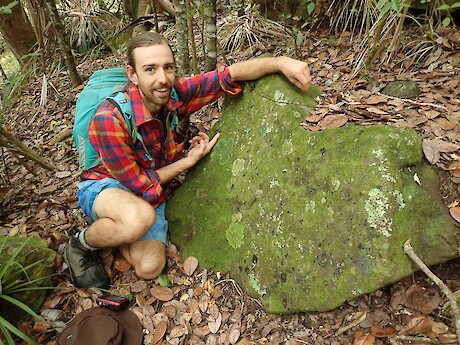 Marley pondering Pannariaceae taxonomy in the coastal forests of Maunganui Bluff, Northland.Kia ora! I’m a ecologist, botanist, mycologist, lichenologist and full time nature nerd committed to exploring Aotearoa and its vast diversity. I grew up in the wild western Far North, the land instilled in me a love for wild places. Once I realised there were rare plants in my local mountains and coast I was hooked. My interests lie in the underappreciated flora and novel landscapes, I feel at home in an Elvin cloud forest dripping in bryophytes and lichens. I recently completed a MSc in mycorrhizal communities of ramarama (Lophromyrtus bullata) with previous studies in ecology and lichenology. I’m a curator and avid contributor to iNaturalist NZ, a council member of the Auckland Botanical Society as well as a diligent article contributor, and a curator of NZPCN’s lichen content. I am now working as a contractor for a range of organisations focused on ecology and botany.
Marley pondering Pannariaceae taxonomy in the coastal forests of Maunganui Bluff, Northland.Kia ora! I’m a ecologist, botanist, mycologist, lichenologist and full time nature nerd committed to exploring Aotearoa and its vast diversity. I grew up in the wild western Far North, the land instilled in me a love for wild places. Once I realised there were rare plants in my local mountains and coast I was hooked. My interests lie in the underappreciated flora and novel landscapes, I feel at home in an Elvin cloud forest dripping in bryophytes and lichens. I recently completed a MSc in mycorrhizal communities of ramarama (Lophromyrtus bullata) with previous studies in ecology and lichenology. I’m a curator and avid contributor to iNaturalist NZ, a council member of the Auckland Botanical Society as well as a diligent article contributor, and a curator of NZPCN’s lichen content. I am now working as a contractor for a range of organisations focused on ecology and botany.
